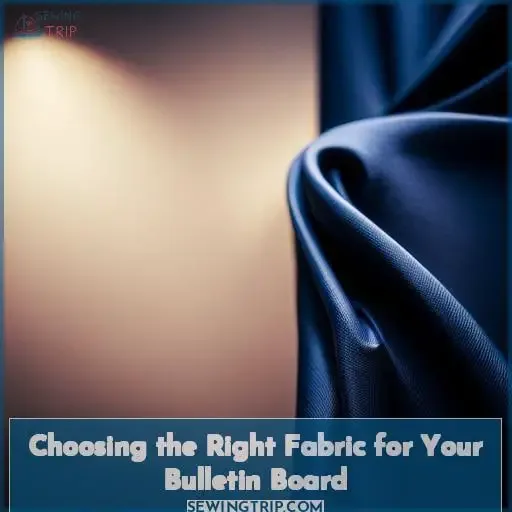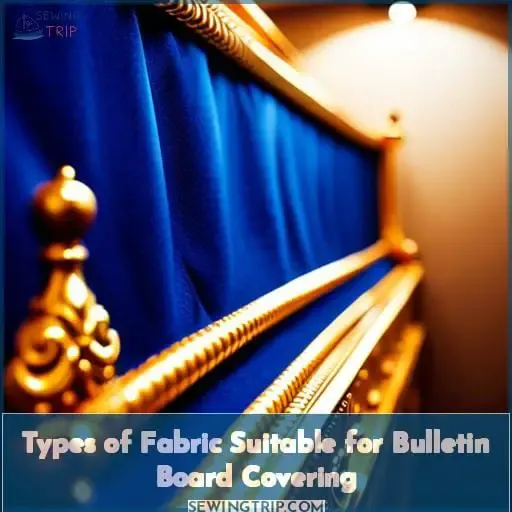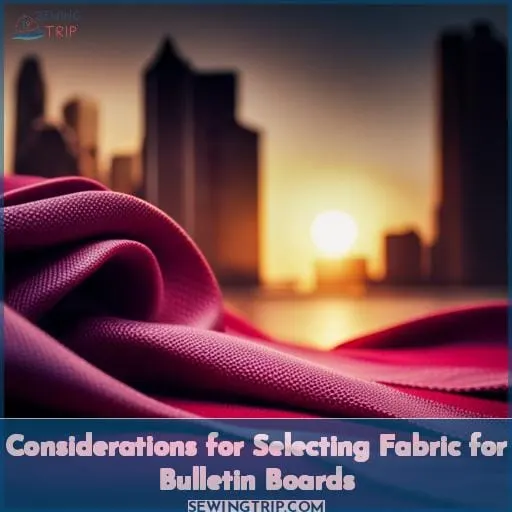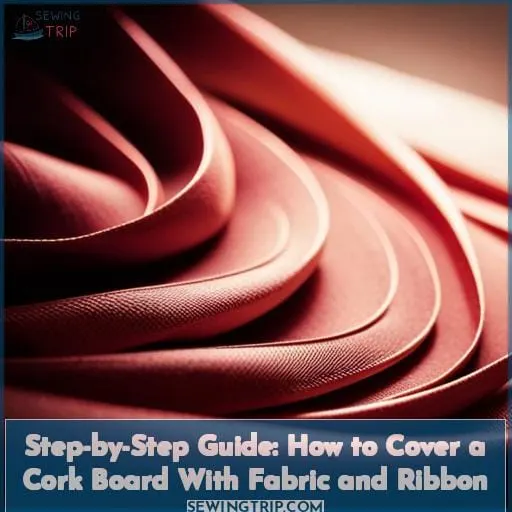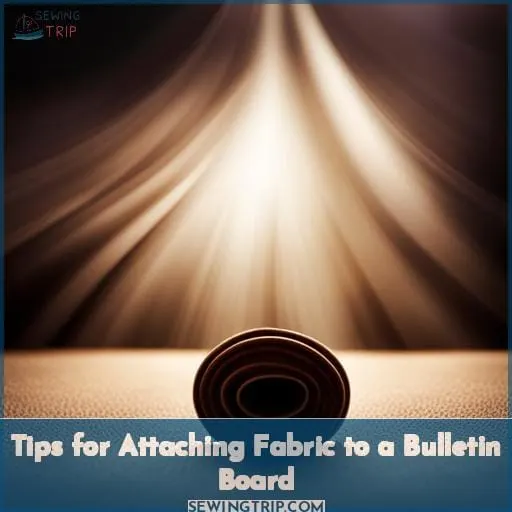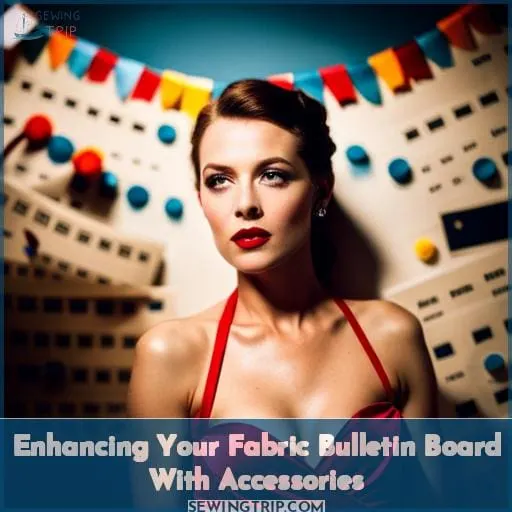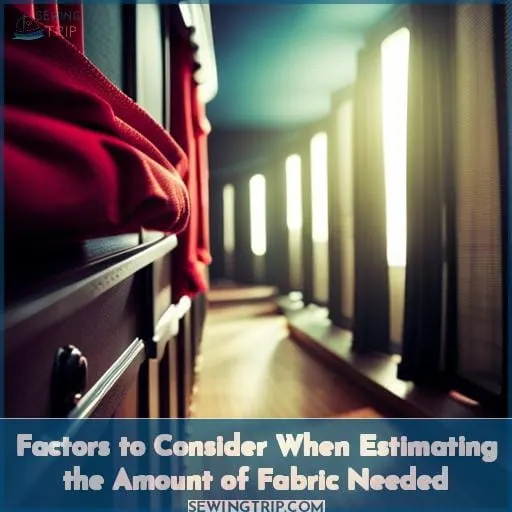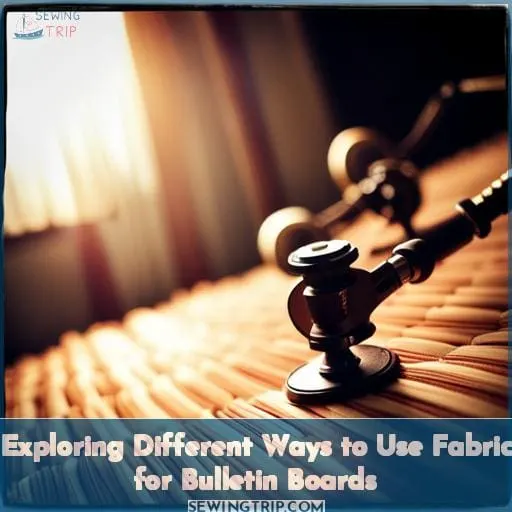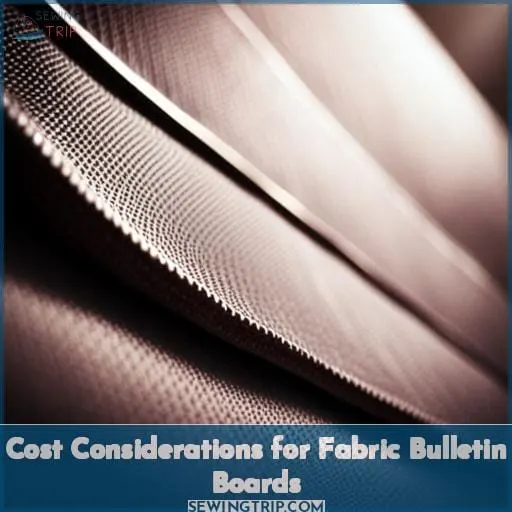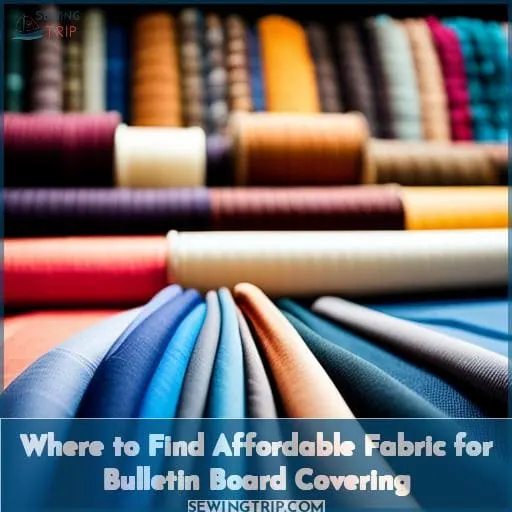This site is supported by our readers. We may earn a commission, at no cost to you, if you purchase through links.
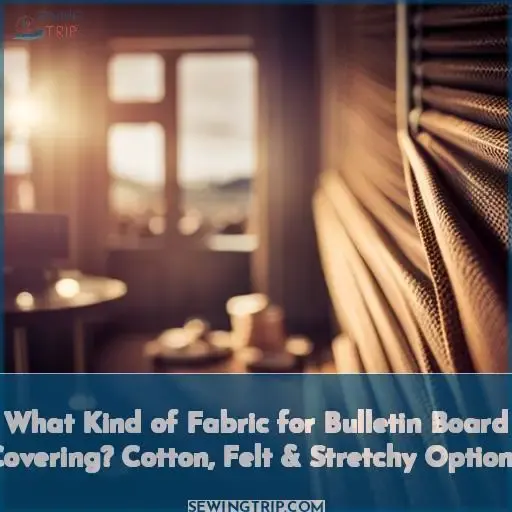 Need a fabric that will transform your bulletin board from boring to beautiful? As many as 53% of homes have at least one corkboard or bulletin board that could use a stylish makeover. Breathe new life into your bulletin board with the perfect covering fabric. Cotton, felt, and stretchy fabrics each have advantages.
Need a fabric that will transform your bulletin board from boring to beautiful? As many as 53% of homes have at least one corkboard or bulletin board that could use a stylish makeover. Breathe new life into your bulletin board with the perfect covering fabric. Cotton, felt, and stretchy fabrics each have advantages.
Cotton is versatile, felt provides texture, and stretchy fabric hugs every curve. Consider durability, patterns, and maintenance needs when making your choice. With the right fabric, you can create an eye-catching focal point that expresses your personal style.
Table Of Contents
- Key Takeaways
- Choosing the Right Fabric for Your Bulletin Board
- Types of Fabric Suitable for Bulletin Board Covering
- Considerations for Selecting Fabric for Bulletin Boards
- Step-by-Step Guide: How to Cover a Cork Board With Fabric and Ribbon
- Tips for Attaching Fabric to a Bulletin Board
- Enhancing Your Fabric Bulletin Board With Accessories
- Factors to Consider When Estimating the Amount of Fabric Needed
- Exploring Different Ways to Use Fabric for Bulletin Boards
- Cost Considerations for Fabric Bulletin Boards
- Where to Find Affordable Fabric for Bulletin Board Covering
- Conclusion
Key Takeaways
- Choose durable fabrics like jersey or knit for long-lasting bulletin boards.
- Opt for cotton fabric due to its versatility, softness, and classic appeal.
- Consider solid or seasonal patterns for your bulletin board design.
- Explore cost-effective options by checking teacher discounts, clearance sections, and thrift shops for affordable fabric.
Choosing the Right Fabric for Your Bulletin Board
When covering your bulletin board, consider the benefits and drawbacks of cotton versus synthetic fabrics. The print, texture, and durability of the material will impact the aesthetic and functionality.
Regular cleaning and maintenance preserves the appearance while avoiding fading.
Cotton vs. synthetic fabrics
You’ll want to go with cotton over synthetics since it’s breathable, natural-feeling, and less likely to pill or fray over time.
- Soft and comfy texture
- Classic look that complements any space
- Has a nice drape and hangs nicely on the walls
- Easy to sew into different shapes and designs
- Comes in tons of fun prints and colors
Cotton is a smart choice for bulletin boards in classrooms and homes alike. It will stand the test of time while bringing a cozy, vintage vibe.
Choosing fabric patterns
Consider opting for visually appealing designs on your fabric choice to make your bulletin board stand out, while avoiding overly busy patterns that might distract from the content you display.
When choosing fabric patterns, think about the themes you’ll use. Seasonal themes benefit from cheerful, bright colors and playful designs. For a more sophisticated look, consider themed designs that match your classroom decor or subject matter.
Keep in mind that optical illusions from busy patterns can make text hard to read.
Here’s a helpful comparison to guide your choice:
| Pattern Type | Suitability | Recommended Use |
|---|---|---|
| Solid Colors | High | Versatile and easy to read. |
| Geometric | Moderate | Adds visual interest, but not too busy. |
| Floral | Low | Can distract from content. |
| Seasonal | High | Great for holiday-themed boards. |
Selecting the right fabric pattern can enhance the visual impact of your bulletin board while keeping it engaging and easy to read.
Durability and maintenance
To ensure your investment lasts, opt for robust, heavy materials such as jersey or knit when deciding on your choice. These fabrics offer exceptional durability and longevity for your bulletin board.
Here are some essential maintenance tips to keep it in prime condition:
- Regularly dust the fabric surface to prevent dirt buildup.
- Use a fabric-friendly spot cleaner for stains or marks.
- Avoid excessive exposure to direct sunlight, which can cause fading.
- Inspect the fabric for any loose threads and trim them promptly.
- If needed, reapply fabric glue to secure any lifting edges.
By following these maintenance tricks, you’ll extend the material lifespan of your bulletin board, ensuring it remains a vibrant and functional part of your space.
Types of Fabric Suitable for Bulletin Board Covering
When considering fabrics for bulletin board covering, you’ll encounter a variety of options to choose from. Cotton fabric is a popular choice, known for its durability and ease of use. Additionally, felt fabric offers a soft texture, ideal for creating tactile boards, while stretchy fabrics like jersey or knit are recommended for a smooth, wrinkle-free finish.
Cotton Fabric
When seeking a versatile option, choose cotton – it’s as adaptable as a chameleon in a field of colors. Cotton fabric, suitable for bulletin board covering, offers several advantages. It’s durable, easy to work with, and comes in a variety of patterns.
Compared to burlap, cotton is softer, making it a better choice if you prefer a smoother surface. Taking care of cotton fabric is straightforward; it’s machine washable and retains its color well. For alternatives, consider thick, stretchy cotton jersey, or knit fabrics. Cotton fabric truly transforms your bulletin board with ease.
Felt Fabric
Opt for felt to create a soft and textured display that adds a cozy touch to your classroom or office. Felt fabric advantages include its versatility, as it’s easy to cut, shape, and work with. Unlike cotton, felt doesn’t fray, making it ideal for intricate designs. Explore creative felt ideas like layered designs or tactile elements.
Felt board DIY projects often involve playful shapes and interactive learning tools.
Stretchy Fabric
Explore the versatility of stretchy materials when it comes to crafting eye-catching displays on your classroom or office walls. Stretchy fabric offers a range of options for bulletin board covering. Unlike felt, it’s often synthetic, providing various patterns and colors.
The pros include cost-effectiveness and low maintenance. Compared to felt, it’s an inexpensive fabric choice. Keep your bulletin board looking fresh with the resilience of stretchy fabric, making it a top choice for your DIY projects.
Considerations for Selecting Fabric for Bulletin Boards
When selecting fabric for bulletin board covering, prioritize durability and longevity by opting for thick, stretchy fabrics like jersey or knit, as they are less likely to tear or wear out over time. Additionally, be mindful of the size and dimensions of your bulletin board, ensuring the chosen fabric is wide enough to cover it entirely without gaps.
For budget-friendly options, explore clearance sections or take advantage of teacher discounts and sales to reduce fabric costs while maintaining quality.
Durability and Longevity
To ensure your bulletin board lasts for an extended period of time, select a fabric that is robust and resistant to wear and tear. Opt for durable materials such as heavy-duty cotton or thick, stretchy fabrics like jersey or knit.
These options can endure the test of time and maintain their appearance. Consider the color carefully, as brighter and solid colors tend to resist fading better than busy patterns. Regular maintenance, like occasional cleaning, will also contribute to the fabric’s longevity, keeping your bulletin board looking fresh and vibrant.
Size and Dimensions
When making your selection, consider the dimensions of your board. Does it effectively fill the available space and provide a visually balanced backdrop for your classroom? Bulletin board dimensions matter; you want the fabric to cover it seamlessly.
Choose a fabric width that accommodates the board’s size with some extra for a neat border. Keep an eye out for teacher discounts to save on fabric costs and consider using ribbon as a stylish border.
This way, you’ll transform your cork board into a powerful educational tool with the right fabric and accessories.
Budget-Friendly Options
Consider budget-friendly options for your bulletin board by exploring the clearance sections at fabric stores or taking advantage of teacher discounts and sales. When it comes to thrifty alternatives, think about burlap choices for a rustic look or patterned fabric for themed boards.
Seasonal selections can be cost-effective, and you can discover budget-friendly fabric sources. Just remember to use spray adhesive, staple carefully, and finish the edges with twill tape for a polished appearance.
Step-by-Step Guide: How to Cover a Cork Board With Fabric and Ribbon
To create a beautifully covered cork board that adds a touch of elegance and functionality to your space, follow this step-by-step guide. In this journey, you’ll learn how to expertly prepare the corkboard, choose the right fabric, enhance the frame with paint, and add ribbon trim for a polished finish.
Your fabric bulletin board will soon be a testament to your interior decor skills.
Step 1: Preparing the Cork Board
First, prepare the cork board by masking the frame with painter’s tape, ensuring a crisp, clean boundary for your fabric canvas. Cut your chosen fabric slightly larger than the cork board frame. Head outside to spray adhesive on the board to avoid fumes indoors.
Carefully align and smooth out the fabric, eliminating any bubbles. Then, trim the excess fabric with a craft knife or rotary cutter. This meticulous preparation sets the stage for a flawless bulletin board covering.
Step 2: Adding Fabric to the Cork Board
Gently align the chosen fabric over the cork board, ensuring it spans the surface smoothly.
- Start from the top and staple the fabric, pulling it tight as you go.
- Work your way down, securing the fabric evenly along the sides.
- Pay attention to fabric stretching; avoid over-tightening to prevent distortion.
- When the fabric is attached, carefully trim excess material to ensure the border conceals the edges.
- Keep an eye out for any remaining bubbles or wrinkles; fabric glue tips can help fix these imperfections.
With these techniques, you’ll create a flawless fabric-covered cork board for your bulletin board needs.
Step 3: Painting the Cork Board Frame
Now, give your cork frame a fresh coat of paint, choosing a color that complements your overall design. Craft paint offers a wide range of colors to match your fabric choice. Consider using contrasting colors for textural contrasts.
This is your chance to infuse creativity into your bulletin board project. Once the frame is painted, allow it to dry completely before moving on to the next step, adding fabric and ribbon for a stylish border that ties the whole look together.
Step 4: Adding Ribbon Trim to Your Cork Board
To add a touch of elegance and style to your cork board, it’s time to incorporate some beautiful ribbon trim.
- Choose Ribbon Color: Select ribbon in colors that complement your fabric and room decor.
- Attach the Ribbon: Use fabric glue to secure the ribbon along the edges of your cork board.
- Create a Decorative Edge: Experiment with different ribbon widths and patterns for unique decorative effects.
- Explore Fabric Embellishments: For added flair, consider attaching fabric flowers or other embellishments.
Elevate your bulletin board with these ribbon trim ideas and fabric embellishments.
Tips for Attaching Fabric to a Bulletin Board
When covering your bulletin board with fabric, mastering the stapling technique is crucial to achieve a polished look. Ensuring a tight and wrinkle-free surface is equally important, and trimming excess fabric neatly will provide a clean and professional finish.
Stapling Technique
When fastening the material to the surface, remember that a stitch in time saves nine. To achieve a polished look, consider the stapling method. Start from the top, pulling the fabric tight to prevent wrinkles.
Ensure fabric alignment as you staple, keeping it taut along all edges. Pay special attention to neat corners for an aesthetic finish. For denim or heavy fabric, use strong staples and space them close together. This approach guarantees your fabric-covered bulletin board stands out with a professional touch.
Ensuring a Tight and Wrinkle-Free Surface
Ensure a smooth and taut surface by pulling the fabric tightly as you staple it to the cork board frame.
To achieve a wrinkle-free bulletin board, follow these steps:
- Start at the top: Begin stapling from the top center, working your way down to the corners.
- Pull and staple: Pull the fabric snugly as you staple, ensuring a firm fit.
- Corners matter: Pay extra attention to the corners, pulling them tight to eliminate wrinkles.
- Trim excess: Trim any excess fabric once you’re done stapling, but leave a border to hide the edges.
- Aesthetics matter: Keep an eye on the fabric’s alignment for a polished and professional look.
Your bulletin board will not only be wrinkle-free but also visually appealing.
Trimming Excess Fabric
Once the excess material is carefully trimmed, ensure that the edges are neatly tucked in to maintain a polished and professional appearance. Clean edges are essential for a neat finish on your fabric-covered bulletin board.
Ensure a precise cut with sharp scissors or a rotary cutter, making sure that the fabric border hides the edges of the corkboard. This attention to detail will result in a bulletin board that looks both clean and well-crafted.
Enhancing Your Fabric Bulletin Board With Accessories
To enhance your fabric bulletin board, consider incorporating decorative ribbons that can increase visual appeal and creativity. In fact, 80% of educators find this an engaging addition to their classroom decor.
Choose ribbons that complement the colors and theme of your bulletin board for a cohesive look. Additionally, colorful pins can add a playful touch to your display while also serving as functional organization tools.
Use different colored pins to categorize information or highlight important notes.
Another way to elevate the style of your fabric bulletin board is by adding theme embellishments, such as small figurines or cutouts related to the subject being displayed. These accessories not only make the board visually appealing but also create a more interactive learning environment for students.
Factors to Consider When Estimating the Amount of Fabric Needed
When estimating the amount of fabric needed to cover your bulletin board, you’ll want to consider a few key factors to ensure a seamless and visually appealing result. Your choice of fabric type, board size, and the desired border play crucial roles in determining the right amount of fabric to achieve a polished look.
Fabric width considerations
When considering the width of the material, choose a size that brings your vision to life and makes your classroom truly vibrant. Fabric width options are crucial for creating a stunning bulletin board. For budget-friendly choices, look for teacher discounts and clearance sections.
Remember that sizing considerations depend on your board’s dimensions. Once you’ve selected the right width, use proper stapling techniques to ensure a neat and professional finish. Your bulletin board will serve as a source of inspiration and information for your students.
Measuring bulletin board dimensions
Before purchasing fabric for your bulletin board, be sure to take note of its dimensions. Measuring accurately is crucial as the width of the fabric, the board size, and installation techniques all rely on these measurements.
A well-measured board will ensure a seamless covering. It’s also important to consider fabric selection in conjunction with the board size, as different fabrics may require varying amounts due to their stretch and thickness.
Therefore, begin by measuring accurately to ensure a successful bulletin board project.
Budget-friendly fabric options
Consider browsing clearance sections at fabric stores to find budget-friendly options, keeping in mind your board’s size and your educator discounts to help reduce costs.
- Clearance options: Check discounted sections for hidden gems.
- Teacher discounts: Many stores offer special pricing for educators.
- Seasonal fabrics: Utilize themed fabrics for festive displays.
- Burlap alternatives: Explore alternatives to traditional cotton for a unique touch.
Exploring Different Ways to Use Fabric for Bulletin Boards
Get creative with your bulletin board design by using fabric in unique ways to make it stand out and catch everyone’s attention. Themed displays are an excellent choice for adding an extra layer of creativity.
Consider using themed fabrics to match the seasons or classroom themes. Burlap fabric can bring a rustic touch, while bright and solid colors can energize the board. However, be cautious about optical illusions from busy patterns, as they can be distracting.
To ensure safety, apply flame retardant spray to the fabric. Fabric sectioning is another intriguing option. Some teachers create sections in their classrooms with fabric-covered walls. This allows for versatile displays and organization.
Plus, fabric is more durable than butcher paper, making it cost-effective. When shopping for fabric, keep an eye out for teacher discounts and clearance sections.
Staple the fabric starting from the top, ensuring a tight pull, and trim excess fabric, ensuring the border hides the edges. With these ideas, you can take your bulletin board to the next level while staying budget-savvy.
Cost Considerations for Fabric Bulletin Boards
When it comes to creating cost-effective yet durable fabric bulletin boards, your choice of fabric is crucial. You’ll want to consider budget-friendly fabric options that don’t compromise on quality while also ensuring the fabric’s durability to withstand the test of time in your educational or work space.
Budget-friendly fabric options
When aiming to stay within your budget for this project, imagine a scenario where a resourceful teacher discovered colorful and textured materials in the clearance section, transforming a simple cork surface into an engaging and cost-effective classroom display.
Keep an eye out for clearance fabrics and teacher discounts; they can be thrifty options for covering your bulletin board. Affordable textiles make it possible to create eye-catching displays without breaking the bank.
Consider these budget-friendly choices for a practical and appealing classroom setup.
Durability of fabric
Opt for robust and sturdy materials like jersey or knit to ensure that your bulletin board stays in top shape over time. Fabric durability is crucial for long-term use, and these fabrics withstand wear and tear admirably.
To extend the fabric’s longevity, remember maintenance tips, such as cleaning occasional stains promptly. The right fabric choice can provide the durability you need for a bulletin board that stands the test of time.
Consideration of board size
Considering the size of your display area, have you measured the dimensions of your bulletin board before purchasing? Dimensional planning is crucial; it ensures the fabric width fits your board. For budget-friendly options, look out for teacher discounts and sales. By getting the right size fabric, you minimize waste and save money, making your fabric bulletin board both practical and cost-effective for your classroom or workspace.
Where to Find Affordable Fabric for Bulletin Board Covering
To discover budget-friendly options for covering your bulletin board, explore clearance sections at fabric stores, where you might find fabric remnants at a fraction of the regular price. Keep an eye out for discounts and sales, as many stores offer great deals on various fabric types.
-
Discount Stores: Check out local discount stores, where you can often find affordable fabric options. These stores frequently carry a variety of fabric remnants and rolls at discounted rates.
-
Online Options: The internet is a treasure trove of budget-friendly fabric sources. Browse through online fabric retailers, marketplaces, and auction websites, where you can often score great deals and find a wide selection of fabrics.
-
Thrift Shops: Don’t underestimate thrift shops; they can be a hidden gem for affordable fabric. Many thrift stores receive donations of unused fabric or old curtains, providing unique and budget-friendly choices.
By exploring these options, you can find the perfect fabric for your bulletin board covering while keeping your costs in check. Your resourcefulness can save you money and give your bulletin board a unique and stylish look.
Conclusion
To create the perfect bulletin board, you need to be as selective as an artist choosing their canvas.
Cotton, Felt, and Stretchy fabrics, each with their unique qualities, are your paintbrushes.
Cotton offers classic elegance and durability, while Felt brings a soft, textured touch.
Stretchy fabrics, like jersey, provide flexibility for creative designs.
The choice ultimately depends on your preferences, from aesthetics to maintenance.
Whether it’s the crispness of cotton, the warmth of felt, or the adaptability of stretchy materials, your bulletin board will tell its own story, thanks to the right fabric. So, what kind of fabric for bulletin board covering? The answer lies in your vision and needs.

